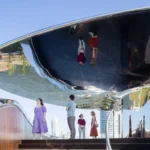How design can catalyze the space-making algorithm in architecture in conversation with award-winning architect Jingwen He, Property advice
Space-making Algorithm in Architecture In conversation with Award-winning Architect Jingwen he
21 May 2025
Architecture is not so much frozen music as indeterminate footage that captured and rendered its interpretations of all the happenings that exist within the space-time sequences, which is relentless and incessant.
The award-winning Architect Jingwen He is sharing her non-ubiquitous visions in terms of fathoming the archetypal possibilities of space-making algorithm in architecture, which could wield substantial impacts on the evolution of design-thinking and problem-solving efficiencies that architects are dealing with every single day. Along with her reputable experience serving as the jury panels for several prominent international design awards, including annual AIA design awards and A’ design award & competition, Jingwen’s design narrative not only focus on articulating the premise of architecture serving as customized containers for live interaction, but catalyzing the incubator functionalism in an attempt to curate cooperations.
From Jingwen’s perspective, architecture is more than just the creation of physical spaces; it is the prime discipline of shaping environments that dictates how people experience and interact with the world. The missions of architects nowadays are complicated by entangled factors from various realms. Contemporary strategies and design ideas were recognized and celebrated in prominent international awards to highlight the value of significant contributions to the common society through their groundbreaking features. Jingwen He, an experienced registered architect in California, United States, has obtained several top-notched design awards across the globe, including Good Design Awards, London, French and Muse design Awards, demonstrating her unparalleled professionalism and transcendent intellectuality in design. In addition, Jingwen’s distinctive bandwidth in defining phenomenal creativity of setting new standards for aesthetics, functionality, and sustainability has shed grand lights on the intrinsic notion of architectural commitments. As the prestigious Award Winner dedicated to pushing the boundaries of art, science, design, and technology, Jingwen introduced us her thought-provoking stories in discovering design impacts that could formulate a strategic algorithm to generate both aesthetically pleasing and habitable manifestation of space that elevates the quality assurance beyond the basic public health and welfare requirements.
In recent years, technology has become an increasingly powerful tool in architecture, especially with the development of algorithms that can optimize and propel the design progress. These space-making algorithms are reconfiguring how buildings are conceived, from the initial concept to the final infrastructure.
Understanding the Space-Making Algorithm
A space-making algorithm refers to a set of rules, processes, or computational mechanisms that help shape the physical layout and form of a building or space. Previously, architectural design was done through hand drawings, sketches, and physical models. Digital tools such as parametric design, artificial intelligence (AI), and computational design algorithms have been widely tested and employed to assist architects in the process of space-making generation in modern epoch. These algorithms optimize variables like space planning efficiency, energy consumption, circulation, light exposure as well as user interaction.
Jingwen told us that one of the most riveting aspects of space-making algorithms is their ability to process vast amounts of data and respond to miscellaneous parameters instantaneously. By adjusting those parameters, architects can explore countless possibilities in the design process and even predict outcomes based on data-driven analysis. For instance, executable algorithms can help architects understand how space will perform in terms of acoustics, ventilation, or natural lighting without relying on conventional trial and error-testing approaches.
Design as a Catalyst for Algorithmic Innovation
While algorithms can automate and optimize aspects of space-making for project-based intentions, they are not independent of human creativity. In fact, it is the integration of design thinking with algorithmic tools that leads to the most impactful and innovative outcomes, as indicated by Jingwen. This synergy between design and technology offers opportunities for architects to push the defined boundaries of what is possible, creating spaces that are not only efficient and functional but also aesthetically inspiring and socially profound.
- Empathy and User-Centered Design
Among Jingwen’s takeways one of the key components when design can catalyze space-making algorithms is by emphasizing empathy and user-centered indications. Architects are typically inculcated to understand the needs of the people who will inhabit or interact with the space. Through design thinking, architects consider not just the aesthetic or structural features of a building but also how the space will be perceived, flow, and function for its everyday users.
When algorithms are deployed in this context, they can be programmed to consider human behaviors, social dynamics, and psychological impacts. From Jingwen’s experience, using generative design algorithms can enable architects to create office spaces that enhance well-being, promote collaboration, or provide privacy depending on the users’ needs. The design intent can therefore direct the algorithm to prioritize certain spatial qualities, like social interaction or tranquility, ensuring that the end result aligns with the planning goals.
- Data-Driven Design Exploration
According to Jingwen, design as a catalyst can also play a significant role in optimizing the potential of data-driven design exploration. Instead of relying solely on intuition, designers can use algorithms to process large sets of data swiftly, such as environmental conditions, urban context, or even behavioral patterns, to inform the decision-making process.
This data-driven approach provides architects with a wealth of information, which can be used to make informed decisions about building placement, orientation, materials, and structural form. For instance, space-making algorithms can simulate how a building will interact with the surrounding environment, including aspects like solar gain, wind patterns, and views. By factoring these variables into the design, architects can create more sustainable, energy-efficient, and contextually relevant buildings.
- Generative Design and Form-Finding
Generative design, a subset of algorithmic design procedure, leverages computational power to create multiple design solutions based on a bracket of predefined parameters. Architects set the rules, such as constraints for the space, material limitations, or aesthetic preferences, and the designated algorithm would explore all the possible renditions.
Jingwen stated that this discourse allows for creative unveiling of form and function, leading to designs that may not have been speculated through typical methodologies. It revolutionizes the conventions of design by incorporating new schema of geometry, scale, and material use.
- Sustainability and Resilience
In an era of climate change and impending environmental challenges, sustainability has become a critical aspect of architectural considerations. As a steadfast advocate of net positive architecture, Jingwen are proactively upgrading her design algorithms, which has so far played a pivotal role in enabling her projects to optimize the energy performance of buildings, making them more sustainable and resilient. Space-making algorithms can also analyze factors such as energy consumption, natural light, passive heating, and cooling, providing architects with insights to reduce waste and optimize resources. For instance, parametric design tools can be used to create facades that adapt to changing environmental conditions, minimizing energy usage and improving the building’s carbon footprint.
Conclusion
According to Jingwen, The fusion of design thinking and space-making algorithms is a quintessential combination that invokes transcendent breakthrough in architecture. By embedding empathy, data exploration, generative design, as well as sustainability into programming sequence, architects can harness the full potential of computational tools to create spaces that not only meet the functional requirements but also enhance the experiential quality for inhabitants in everyday lives. Sitting at the forefront of AEC industries, prominent design awards are slated to identify and promote good designs, as well as arousing global awareness of intellectual shifts in architecture. As the winner of several gold awards and jury panels, Jingwen was exposed to the most renowned, magnum opus works constantly, leading to her inspirational wish to witness eminent leap in architecture and be able to embrace the genuine tech-arch interface in the upcoming future.
Published by Marcus Johnson
Comments on this How Design Can Catalyze the Space-making Algorithm in Architecture In conversation with Award-winning Architect Jingwen he article are welcome.
Architecture Design
Architectural Design
Archive: Architecture Design
Archive: Bedroom Design
Archive: Building Design
Archive: Building Construction Design Guide
Archive: Building Materials
Building
Architecture Articles
Comments / photos for the How Design Can Catalyze the Space-making Algorithm in Architecture In conversation with Award-winning Architect Jingwen he page welcome





